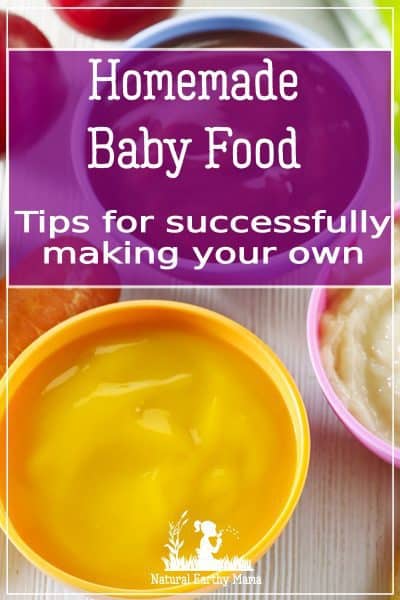 Making your own homemade baby food is much easier and cheaper than many think, and can be quick to prepare with a little planning. By creating your own portion sizes you cut down on waste and unused food from cans or jars. Also, you have the ability to control every single ingredient that goes into your child’s mouth. You can create endless flavor combinations of fruits, veggies, and meats.
Making your own homemade baby food is much easier and cheaper than many think, and can be quick to prepare with a little planning. By creating your own portion sizes you cut down on waste and unused food from cans or jars. Also, you have the ability to control every single ingredient that goes into your child’s mouth. You can create endless flavor combinations of fruits, veggies, and meats.
Weaning your baby on to solids is full of well meaning advice, and do’s, don’ts and varying opinions and trends. At the end of the day there really is no “right” way to do it.
Please read: This information is provided for educational purposes only and is not intended to treat, diagnose or prevent any disease. We encourage you to make your own health care decisions in partnership with a qualified health care professional.
This post contains affiliate links, this means at no extra cost to you, we make a commission from sales. Please read
our Disclosure Statement
The World Health Organization recommends that babies only start solids at 6 months, but a week or two is unlikely to make a difference one way or the other. If you have major food allergies in your family it is best to wait to introduce those foods until baby is over 1. In our family, we avoid grains for our babies as they cannot properly digest them until they are over one.
Your baby is likely to be ready to try solids when:
• Your child has good head and neck control.
• Your child is able to sit well with little or no support.
• When you put a bottle or spoon in front of your child they show interest by opening their mouths or trying to reach for the object.
Coming up with your own combinations of foods can be a lot of fun, but if you are running short of ideas, have a look at the cans of baby food at the supermarket, and make your own versions of similar combinations.
It isn’t imperative that one type of food be introduced before the other, but there are a few recommendations that may help the process go smoothly.
1) Introduce vegetables first.
The idea behind this is that your child may be less willing to give vegetables a chance after discovering the sweet flavors of the fruit.
2) Try starting baby with soft cooked egg yolk
Egg yolk is the perfect first food. Mash it with a with small amounts of vegetables or simply some breastmilk. Egg yolks are very nutritious and easy to digest.
3) Add meat/bone broth
Cook your vegetables in bone broth, or add some finely grated frozen beef liver in with vegetables right from the beginning, they contain iron and minerals in very accessible forms.
4) Prepare and serve foods plain
Babies do not need you to add any additional sugar, salt, or seasonings.
What’s wrong with baby cereal?
To digest grain your body needs to produce amylase. Babies don’t make amylase until they are somewhere between 1 and 2 years of age. Traditional cultures don’t feed their babies infant cereal (AKA baby rice).
Among the few cultures who fed their babies a gruel of grains, their practice radically differed from what we do today. They are only introduced after the baby was more than a year old. Also they ensure that the gruel was mildly fermented by soaking the grains for 24 hours or more, making them much easier to digest.
Why does this matter? Surely they just go straight through them undigested then? Unfortunately, no.
“All Diseases Begin in the Gut.”- Hippocrates
Undigested grains can wreak havoc on your baby’s intestinal lining. It causes an imbalance of bacteria in their gut which then can lead to lots of complications as they age including: food allergies, behavioral problems, mood issues, and more. Is it any wonder these allergic conditions are on the rise in the west?
RELATED POST: The affect of your gut on your brain
Cereals have very little nutritional content compared with other foods. They are predominately carbohydrate and fiber, with very little nutrients, fats or protein. When you have a limited belly space and high nutrient requirements, these should really be the priority.
Giving babies empty calories in the form of cereal instead of real food takes away from what they should be eating.
What should we feed our babies then?
For the first 6 or so months breast milk or a suitable formula is all they need. After that try:
• Offering small amounts of boiled yolk from pasture fed free-range hens is an ideal first food. Avoid the white as it contains hard to digest proteins that can set off allergies.
• Bananas are one of the rare carbohydrate foods that actually contain amylase which makes them easier to digest.
• Steamed vegetables mashed or cut into sticks.
• Butter and coconut oil mashed into vegetables or egg yolks. Babies need plenty of saturated fats to ensure they have enough building blocks to make brain cells, their nervous system, and cell membranes as well as supplying energy.
• Liver and meat. Babies need the iron and protein provided by meat and liver. Liver is best stored in the freezer (raw) and simply grated into hot vegetables.
• Bone broth contains soothing collagen and many minerals from the bones. The bone broth is ideal to cook vegetables in or to mash them with. Simply simmer bones for 5 or more hours to get the minerals out of the bones. Chicken frames are ideal for this. The soft meat can then be fed to baby too.
If you have already weaned your baby on to cereals it is not too late to swap what they are eating, going for more natural, nutrient rich foods. Your baby will thank you for it.
Preparing homemade baby food
Before you start, some food safety!
• Always wash your hands prior to preparing any foods.
• Work on a clean surface with clean equipment, cooking utensils and a clean storage container
• Never cross contaminate surfaces by cutting vegetables or fruits on the same surface on which you previously cut raw meat.
The easiest way to prepare fruit or veges is in a pot with a little water or bone broth. This will completely cook the foods, and will also aide in breaking them down making it easier for your baby to digest them.
1) Select your vegetables/fruit
Try to get organic, local food if possible. Try combinations like broccoli and peas, sweet potato/kumara and carrot, pumpkin and sweet corn, apple and apricot, pear and blackberries.
2) Wash, peel, chop your vegetables or fruit in to 1/2 inch cubes.
You can do this in small amounts fresh each meal while you prepare the rest of the families dinner, or you can do it in bulk ie a bag of apples at once, a whole pumpkin at once etc and freeze for later.
3)Cook the vegetables
Place in a pot with 1 inch water or bone broth in the bottom and cook until the food is soft – 10-20 minutes.
4)Mash or leave whole
Now you have two choices – to go the finger food/ baby lead weaning way, or the more traditional puree way.
For finger food, let the food cool and plop it in front of baby and let them go for it.
For puree add a little butter, breast milk, coconut oil, bone/meat broth or vegetable cooking water and mash with a fork, puree in a food processor or use a stick blender.
5 )Store it for later
If your food is pureed, storing it in covered ice cube trays (or for larger portions use silicone muffin tins) and pop into the freezer.
This is great if you are doing a whole lot of one type of vegetable at once, then you can grab one cube of broccoli, one of pumpkin and one of sweet potato, defrost and mix together with ease. It is also easy to defrost a little more if baby is still hungry!
These containers are the perfect sizes for storing homemade baby food
Tip for defrosting: Be careful using the microwave, as they leave hot spots in the food, so if you do use it, stir, stir, stir well and leave it to sit for a few minutes before serving. To avoid the microwave, heat the food in a bowl over a pot of hot water.
Making Bone Broth:
Making bone broth is very easy and incredibly nutritious. It contains minerals from the bone, soothing fats (for nerve and brain growth) and gelatin (for the immune system) from the meat and connective tissue, protein from the meat and the all important iron.
Choose chicken frames or beef shin bones. Add these to a deep pot or slow cooker with plenty of water. Babies don’t need additional salt or seasoning, but you may like to add some chopped carrots or celery for additional nutrients.
Put over a slow – medium heat and simmer slowly for many many hours (at least 3, up to 24). Check the water level regularly and top up as required. When finished, strain the liquid in to ice cube trays and freeze. Once frozen, tip out into a labeled zip-lock bag and store in the freezer. These can then be added to sauces, and baby’s food.
Home made baby food is much much cheaper, tastier and more nutritious than bought preserved food. Give it a go! Baby doesn’t know conventional food combinations, so feel free to experiment!
